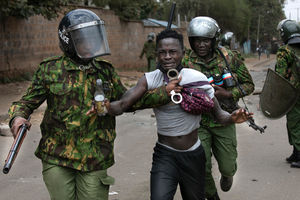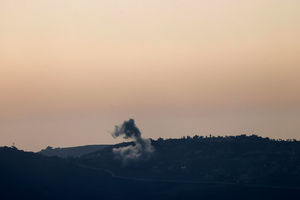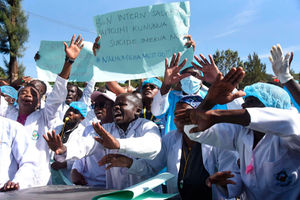Early cancer detection and treatment: We can, I can despite the hurdles

What you need to know:
- The day espoused exploring how everyone – collectively or as individuals – can do their part to reduce the global burden of cancer. It is therefore prudent for Your Health Magazine to look deeply into the reason why and how early diagnosis and treatment can save lives while preventing the disease.
This year’s World Cancer Day 2018 was commemorated on February, 4th. It took place under the tagline ‘We can. I can.’
The day espoused exploring how everyone – collectively or as individuals – can do their part to reduce the global burden of cancer. It is therefore prudent for Your Health Magazine to look deeply into the reason why and how early diagnosis and treatment can save lives while preventing the disease.
The seriousness with which the government takes the disease coupled with the rising numbers of cancer patients and deaths, dispelling the myths surrounding it and exploring the emerging trends that have been changing year after year need exploring.
Early screening means ease of cure.
Reported cancer cases and deaths are on the rise to more than 100 new cancer cases in 100,000 people every year in Tanzania. With a population projected to rise from 46 million recorded in 2010 to 58 million as projected by Department of Economic Affairs, Population Division, the estimated reported new cancer cases stand at slightly more than 50,000 new cases each year.
According to Dr Harrison Chuwa, a consultant oncologist at the Aghakhan Hospital Dar es Salaam, statistics vary from different sources in the country hitherto but stand at roughly 50,000 new cases a year.
“At the moment, we do not have a population based cancer registry in the country but we rely more on the Ocean Road Cancer Institute for the statistics. For example, about 1,000 new cases were recorded per year when Ocean Road Cancer Institute (ORCI) was mooted but today, a whopping 5,000 new cases are recorded yearly. About 17,000 follow up cases were recorded from the same period but today, the number of follow-up cases stands to about 20,000 ” he said.
According to Dr Chuwa, the number of cancer cases has risen not only because of the increase of cancer prevalence but also improved cancer awareness and infrastructure.
“More cancer patients have lately been showing up for screening because improved physical infrastructure that make access to the screening facilities but the government has stepped up screening programs to 100 more cancer screening centers and dedicated days along with better trained the staff ,” he added.
Traumatic but not sound of death knell
Not one single disease can elicit the emotions of finality and a sense of despair than cancer. The “c” word is devastating to the ears and the mind of the patient and relatives. It is arguable that things come to an abrupt standstill when the disease rears its ugly head in individual’s life.
Being diagnosed with cancer, almost always sounds a death knell to the patient. Any time a patient or his/her biopsy (a sample of your tissue or your cells to help diagnose an illness or identify a cancer) is referred to Ocean Road Cancer Institute, the patient waits with bated breath, anxious that the outcome could be positive, signaling the end.
A small lump in the breast, cervix, colon or any other part of the body is certainly worrisome. Most cancer cases go unnoticed until it is too late – the disease has already eaten into the body. There is obviously a complete change in a patient’s lifestyle.
For Maria Robison*, 49 a teacher from Musoma, since she was diagnosed with breast cancer, life has never been the same. She has had to shuttle between Dar es Salaam and Musoma and her family life has been completely altered.
“I learnt about self-diagnosis of breast cancer on TV. During one of such self-tests, I noted a small lump in my left breast and after biopsy, the situation worsened. I was referred to Bugando Hospital for further treatment that further referred me to Ocean Road Cancer Institute. I am awaiting mastectomy,” said she.
Some years back, this writer’s late father and he were clearing the compound in preparation for his sister’s wedding. Accidentally, he cut himself and so much blood uncontrollably gushed out of the wound that did not clot for many hours.
Little did they know that one of the earliest symptoms blood cancers (leukemia) was inability for blood to clot. Only after manifestation of spleen swelling and subsequent bone marrow tests was it conclusively confirmed that he was suffering from leukemia. A month or so, we lost a colleague to the same disease.
Late screening and mortality
International Agency for Research on Cancer (IARC) of the World Health Organization (WHO) recognises the fact that 80 per cent of patients are not diagnosed until after advanced stages of the disease and that mortality.
Dr Chris Peterson, a physician based in Dar es Salaam says that screening and diagnosis says that most cases are diagnosed in their late stages and by the time they are referred, it is already too late. Cancer comes with not only emotional and social cost but also financial costs.
“People are advised to take regular screening and tests and not wait until it is too late. Indeed, most patients die because many cancer cases are diagnosed late and “accidentally,” he says.
Contrary to the wide held belief that diagnosis with cancer equals death, Dr Chuwa says that treatment depends mostly on the stage and the type of cancer, curing the disease is possible.
“Broadly speaking, cancer could either be “solid” such as growths or “liquid”, that is hematological (has to do with blood such as leukemia). Common treatments may include surgery, chemotherapy, radiotherapy or a combination of the three. However, there are very few oncologist especially surgical oncologists, ”
Further, he noted that patient who has been treated for cancer is considered cancer free if there is no evidence of cancer for five years without relapse. Cure probability of a cancer patient depend on the disease stage.
“There is at least 75 per cent probability of getting cured if the disease is diagnosed at the first stage. At stage 3, the probability of curing stands at 40 to 50 per cent while at stage 4, cancer is incurable,” he adds.
Situation on the ground
Ministry of Health, Community Development, Gender, Elderly and Children (MoCDGEH) recognises the need to expand comprehensive cancer treatment and diagnostic services through National Cancer Control Strategy (NCC 2013-2022).
The government Strategy recognizes that cancer does not only cause 7.9 million (13 percent of mortality), but also 80 percent of reported cancer cases die. Owing to the seriousness it attaches to cancer, the government has established measures that include primary prevention, early detection (screening and diagnosis), infrastructure, treatment and palliative measures.
Government screening facilities are free of charge. Agha Khan offers screening facilities at a subsidized cost.
Dr Chuwa says that as per WHO requirements, one radiotherapy machine is the requirement for population of 1 million. What this means is that there ought to be about 50 such machines in country and this is a tall order.
“There are more basic imaging equipment including x-ray and ultrasound available than before. This has enabled doctors around the country to perform initial diagnostic procedures and refer patients to referral hospitals. Advanced imaging including MRI and CT scan are available in referral hospitals but are fewer. There are 2 machines at ORCI, another at Bugando Hospital. ORCI is expecting to add two more in their stock. Agha Khan also has these machines and is poised to include more sophisticated PET scan.
He cautions against patients’ urge to travel to India for PET scan. Positron emission tomography (PET) scans are used to produce detailed 3-dimensional images of the inside of the body sometimes in conjunction with MRI and CT-scan.
“Many Indian hospitals have duped so many people to believe that PET scan is the answer to their imaging problem. Most of them have had to sell their property. This particular scanner though different, the results are often not so different from what CT scan and MRI can deliver. Besides, the same imaging facility will be available here in a few months after the only one in East Africa based in Agha Khan Nairobi”




